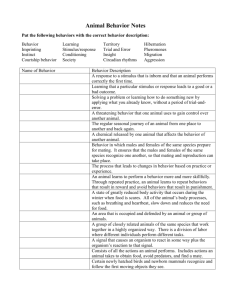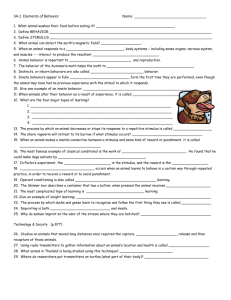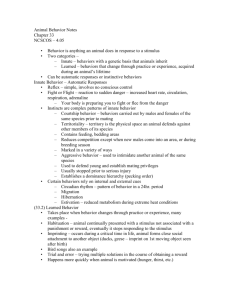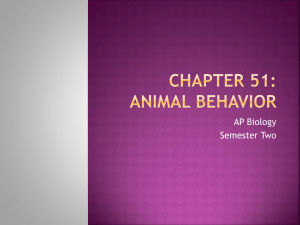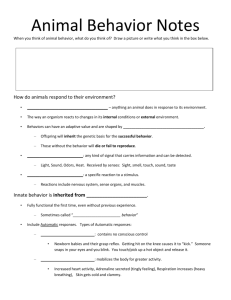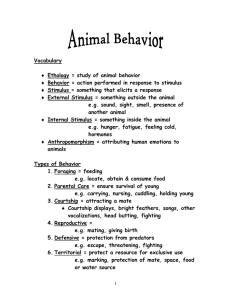ANIMAL BEHAVIOR Ch 51 Animal behavior involves the actions of
advertisement
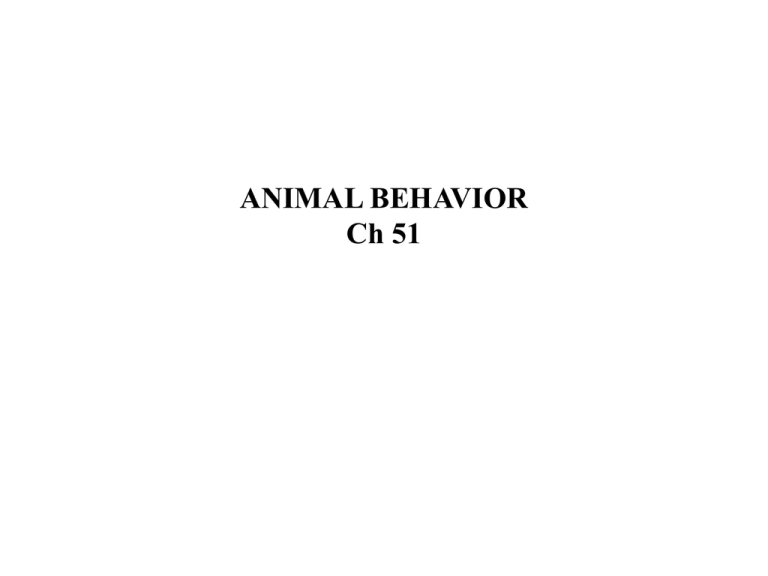
ANIMAL BEHAVIOR Ch 51 Animal behavior involves the actions of muscles and glands, which are under the control of the nervous system, to help an animal respond to a stimulus Behavior is subject to natural selection The following questions are considered when analyzing animal behavior: • What is the stimulus that elicits the behavior and what is the physiological mechanism of the response? (proximate cause) • How do animal’s experiences influence the response? (proximate cause) • How does the behavior aid survival and reproduction? (ultimate cause) • What is the evolutionary history of the behavior? (ultimate cause) • Proximate cause: what mechanisms enable the animal to exhibit the behavior • Ultimate cause: how did the behavior come to be? Behavior can be innate: developmentally fixed behavior and nearly all members of population exhibit the same behavior Behavior can be learned: behavior is modified thru experiences I. KINDS OF ANIMAL BEHAVIOR A. Fixed action patterns • A sequence of unlearned acts that is unchangeable and is usually carried out to completion • Example: male stickleback fish (they have red bellies) will attack other males that invade their nesting territories but won’t attack females (no red bellies) What is the stimulus? How could they prove this? B. Oriented movement • Kinesis: undirected movement of an animal in response to environmental condition Pillbugs are more active in dry conditions than in moist conditions. Why? • Taxis: directed movement towards or away from a stimulus. Ex: trout orient themselves upstream. Why? • Migration: seasonal movement of animals for long distance o Is circannual o follow sun’s position in sky, Earth’s magnetic field or North star o What might be the stimulus to initiate migration? o Depending on species of bird, it can be innate or learned o How would they determine if it is innate or learned? C. Behavioral rhythms • Behavior that follows a biological clock o Circadian rhythms follow a daily clock like nocturnal vs diurnal animals o What is the cue? o Circannual rhythms follow a yearly clock like mating and migration o What is the most common cue? Explain the biological rhythm of the fiddler crab D. Animal communication: • transmission of a signal from one animal induces a behavior in another. • Most animal communication is innate • Chemical communication: signal secreted by one animal o Can involve pheromones that are secreted by females to indicate readiness to mate Other types of chemical communication? • Visual communication o To show courtship or aggression: baring teeth and courtship dances • Auditory • Tactile = touch o Greeting, grooming. E. Habituation • animal learns to ignore meaningless stimulus • allows animal’s nervous system to focus on stimuli that signal food, a mate, or real danger • What effect does habituation have on fitness? F. Imprinting • A learned behavior that is acquired ONLY if appropriate stimulus is provided during the CRITICAL PERIOD • Once behavior is acquired it is irreversible • In birds, young imprint on parent and learn basic behaviors of their species. • If critical period passes without imprinting, then species-specific behavior is not learned G. Associative Learning • Learned behavior where one environmental feature is associated with another o Classical conditioning = arbitrary stimulus is associated with a reward or punishment • social learning = animal learns by observing other animals • Insight = animal performs a behavior without being learned o Operant conditioning = animal learns behavior thru positive or negative stimulus II. Genetics of Behavior A. Is behavior the result of genetics or is it learned? • Genes provide the instructions for behavior • Nongenetic factors can modify how instructions are carried out • Some behavior is more genetic than learned and visa versa. B. The purpose of behavior is to enhance survival What is natural selection? Genes for behavior have evolved by natural selection in order to enhance survival 1. Foraging behavior • Foraging: food-obtaining behavior • Benefit of foraging: nutrition • Cost of foraging: energy expenditure, risk of predation • Therefore any foraging behavior that minimizes costs while maximizing benefits would be favorable 2. Mating behavior • Mating behavior involves, attracting, choosing, and competing for mates and the care of offspring • Any behavior that maximizes this is favored Intrasexual selection: competition between members of the same sex for a mate Intersexual selection: where one sex chooses mate based on certain traits

